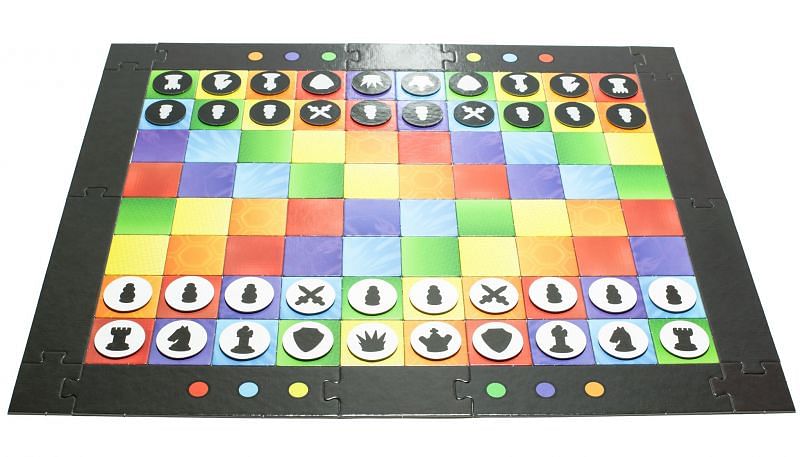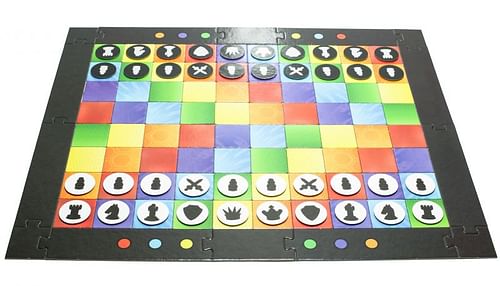
Colour Chess: Thinking Beyond Just Black and White

Chess in its original form has a beauty that can't be questioned. The game has been played since centuries, but many don't know about some variations that have arisen from the main rules. One such variation is colour chess.
DogEared games have come up with some unique ideas on colour chess. It is a form of chess where the board is not the usual black and white. That's what I will reveal for now. So, let's see what exactly this version of chess is all about by reading the interview with the owner of DogEared Games, Tom Norfolk, who is passionate about this idea and is one of the visionaries behind this novel variation or 'novelty' in chess linguistics.
Can you please explain how you came up with the idea of colour chess?
I had created an abstract strategy game called 'Lure', where the initial concept was to allow players to manipulate each other's armies on a board using colours. Once this was finished, I experimented with additional mechanics using chess pieces. I started off by combining one or two pieces at a time, and then later swapped in the whole chess set. It needed some final tweaking of the rules to get the right feel and create the final version that became Colour Chess.
What exactly is colour chess?
Colour chess is chess but played on a board that is mix of coloured tiles. These tiles can be arranged randomly, patterned, or one can competitively build the board with one's opponent before the game. Each game plays differently based on the board, so one must adapt one's strategy in every game.
After the first move, each player has two parts to their turn; in the first part you must move to the colour that your opponent last moved to, then in the second part you must move a different piece onto a different colour. Your opponent then copies this colour.
The result is that you spend part of your turn being forced into a dangerous situation, then the second part trying to escape it and reverse the difficulty back to your opponent. Using colours to force movement allows for some incredibly ingenious manoeuvres, yet it retains a lot of the feel of traditional Chess as the positional logic is still at its core.
How does one start playing this variation of chess?
There are a few ways,
- Download the free app: https://www.dogearedgames.com/colour-chess-app/
- Get a copy of the physical game 'Colour Chess + Lure' which is a collection of variations using the colour mechanics: Available online https://www.dogearedgames.com/colourchess/ or in some high street games shops (or find a friend/club who has a copy)
- Print out an example board and grab some Chess pieces: https://www.dogearedgames.com/colour-chess-pnp-boards/
A quick how to play video will get you started:
https://www.youtube.com/watch?v=5h03T_fwcHk
Then you can progress onto these tips for more advanced play:
https://www.dogearedgames.com/colour-chess-tips-and-tricks/
What benefits does one get by playing this variation for one's classical chess game?
I can't speak for others, but I personally feel more competent at classic chess having played a lot of colour chess. Whether I would have found the same improvement had I spent the time playing classic Chess instead, I can't say!
I think Colour Chess really stretches your logical thinking; what looks like chaos at first, forms into a controllable battleground the more you focus on it. You have to be very aware of the inter-reliance of pieces, as having two turns and the ability to force on colour creates some incredibly complex support webs, which tend to build for the first part of the game and then get slowly unravelled or brought crashing down.
It will also hone your strategic process; developing your position is still key, but you must balance this with controlling the options on different colours and responding to your opponent's machinations. Being able to fluidly adapt your strategy is crucial.
Can you talk about your partnership with the Mind Games in London?
We met Ankush Khandelwal at our stand at the UK Games Expo a few years back; Ankush is a regular competitor at the Mind Sports Olympiad (he won the prestigious Pentamind award last year) and having tried Colour Chess suggested that we get in contact with the organisers.
We arranged a demo session of the game and were invited back the following year for the first official World Championships.
The event had a really positive reaction and after competing himself, International Arbiter David Sedgwick suggested it become a regular fixture at the MSO.
How has the response been so far with this variation?
We are almost always initially met with scepticism, with objections like 'it's not Chess' and 'if it was any good it would already have been made'. I think over the years people have become highly resistant to variations based on the sheer number that exist. We find it usually takes several games before players assimilate the rules and have the 'lightbulb moment' where they realise quite how devious you can be and the level of control you can exert over the other player, and that's when they really get stuck into the game.
How does competitive play work for this variation?
To balance randomness of the board with the speed of setting up the game for tournaments, we give each player an almost identical number of each colour for their half of the board, which they then randomly distribute. With more time available and for those more experienced, players alternately fill-in anywhere in the board from the corners from a shared supply of tiles. We ran a Swiss pairing for the MSO and made sure to allow enough of a time increment to allow for the two moves in a turn.
Have any Grandmasters or other titled players heard of this variation? What has there response been, if any?
Our highest ranking Chess player is GM Matthew Sadler, who said it was a "very interesting problem to get your pieces developed efficiently while trying to inconvenience your opponent! Lots of fun!" Matthew is currently the highest ranking player on the Colour Chess app's leaderboard; I managed to beat him once while he was still learning the game, but since then he has been absolutely untouchable. He has an unnerving ability to turn my own moves against me and force me to provide him with the colours he needs to compound my difficulties.
We're also in the process of arranging a Twitch stream with the GingerGM Simon Williams.
Can artificial intelligence and engines replicate this variation?
In Colour Chess you must think widely due the breadth of strategies available to you on each turn, but it is harder to think more than a few turns ahead because of the opponent's influence over your pieces. I think an AI would have a massive advantage over a human player, as it would need a relatively shallow search to find solutions that a human would struggle to spot.
What is the future that you see in this variation of the game?
We would like to continue building on the competitive scene and work towards establishing more regular events, as well as continuing to update the app based on user feedback.
We are also slowly expanding the list of classical chess variations that the coloured board can be incorporated into, for example, Bughouse and Atomic chess, as we've found most variations can be accommodated with a little rule tweaking and the modular board of the physical game allows you to create almost any game setup: https://www.dogearedgames.com/colourchess/variations/
Most of all though, we want to keep playing and sharing the game with people!